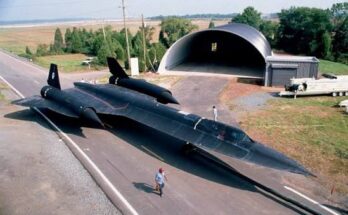
Inferno in the Sky: Boeing 747’s Emergency Return to Miami After Engine Fire
Passengers aboard a Boeing 747 experienced a terrifying ordeal when one of the aircraft’s engines caught fire mid-flight, forcing an emergency return to Miami International Airport. The dramatic incident, which could have ended in disaster, highlighted both the dangers of mechanical failures and the expertise of pilots trained to handle such emergencies.
A Routine Departure Turns Perilous
The Boeing 747, a workhorse of the skies, had taken off from Miami International Airport bound for an international destination. Onboard were hundreds of passengers, unaware that their flight would soon turn into a life-threatening situation.
Shortly after takeoff, as the plane climbed to its cruising altitude, an explosion-like sound startled passengers seated near the wing. Those looking out the windows were horrified to see flames erupting from one of the aircraft’s four massive engines. Smoke and sparks trailed behind the plane, causing immediate panic among passengers.
Inside the cabin, fear took hold as people clutched their seats and murmured prayers. The smell of burning fuel seeped into the air, adding to the growing alarm. Flight attendants quickly moved to calm the passengers, reassuring them that the pilots were handling the situation.
Cockpit Crisis: Pilots Take Control
In the cockpit, the flight crew swiftly assessed the situation. The aircraft’s warning systems had already indicated engine failure, and flames were visible from the instruments’ camera feed. The captain, a seasoned pilot with years of experience flying large commercial jets, immediately declared an emergency and contacted air traffic control.

“Mayday, mayday! We have an engine fire. Requesting immediate return to Miami,” the pilot reported, his voice steady despite the severity of the situation.
Air traffic controllers quickly cleared a return route, prioritizing the aircraft’s landing as firefighters and emergency responders were placed on high alert. The pilots shut down the affected engine, a standard procedure to prevent further damage or explosion. However, flying a massive aircraft like the 747 with one engine out still presented challenges, requiring immense skill and precision.
Passengers Brace for Impact
Back in the cabin, the mood remained tense as passengers followed emergency instructions. Oxygen masks were not deployed, as the cabin pressure remained stable, but the flight attendants conducted safety checks and ensured that everyone was prepared for an emergency landing.
Some passengers recorded the event on their phones, capturing the sight of the burning engine and the tense atmosphere inside the aircraft. Social media quickly buzzed with breaking news about the unfolding emergency.
Despite the fear, the professionalism of the flight crew helped maintain order. The pilot’s voice came over the intercom:
“We have the situation under control. We are returning to Miami and expect a safe landing. Please remain seated and follow crew instructions.”
The Emergency Landing
As the crippled Boeing 747 approached Miami International Airport, firefighters and paramedics lined the runway, ready to respond to any escalation. The pilots executed a textbook emergency landing, touching down smoothly despite the reduced power from the failed engine.
The moment the plane came to a stop, emergency crews rushed to the scene. Firefighters quickly doused any remaining flames, while paramedics stood by to assist anyone needing medical attention. Fortunately, no injuries were reported among the passengers or crew, a testament to the pilots’ expertise and the effectiveness of safety protocols.
Passengers erupted into applause, relieved to be safely on the ground. Many expressed gratitude to the pilots and flight attendants, acknowledging their bravery and professionalism in handling the crisis.
Investigating the Cause
With everyone safe, the focus turned to determining what had caused the engine fire. Aviation experts and engineers from the airline, along with officials from the Federal Aviation Administration (FAA) and the National Transportation Safety Board (NTSB), launched an immediate investigation.
Initial reports suggested that the fire could have been caused by a mechanical failure, possibly due to a turbine malfunction or a fuel system issue. Maintenance records of the aircraft were reviewed, and investigators worked to determine whether human error, improper maintenance, or a manufacturer defect played a role in the failure.

Engine fires, though rare, are taken extremely seriously in the aviation industry. Modern aircraft are designed to withstand such failures, with fire suppression systems and redundant engines allowing pilots to maintain control. However, any incident of this nature raises concerns about safety protocols, maintenance procedures, and airline accountability.
Lessons Learned and Industry Response
This incident served as a stark reminder of the importance of rigorous aircraft maintenance and the expertise required to handle in-flight emergencies. Airlines worldwide took note, reinforcing the need for stringent safety checks and ensuring that their pilots remain well-trained for such scenarios.
Passengers, too, gained a newfound appreciation for the complexity of aviation and the professionals who make air travel as safe as possible. While many expressed hesitation about flying again soon, others acknowledged that the successful handling of the emergency reaffirmed their trust in modern aviation safety measures.
Conclusion
The dramatic mid-air failure of the Boeing 747’s engine could have led to catastrophe, but thanks to quick decision-making, expert piloting, and emergency preparedness, a disaster was averted. This incident, while terrifying for those onboard, ultimately demonstrated the resilience of aviation safety protocols and the skill of those who keep the skies safe.
As investigations continue, the aviation industry will undoubtedly learn from this event, ensuring that the lessons from Alaska Airlines Flight 2221’s emergency return to Miami contribute to even safer air travel in the future.


